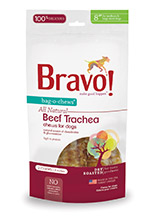Bravo Bag-O-Chews Beef Trachea Review
PawDiet has been helping pet owners since 2015. To fund our efforts, articles may include affiliate links; if you buy something through a link, we may earn a commission.
Review of Bravo Bag-O-Chews Beef Trachea
According to our most recent data, this product is intended for intermittent or supplemental feeding only.
Review of Ingredients
In our review of Bravo Bag-O-Chews Beef Trachea, we'll examine all 1 ingredients and highlight the nutritional contribution of each ingredient.
While the first few ingredients typically dominate the recipe's composition, ingredients in small quantities can still have a meaningful impact on the overall nutritional profile of the recipe.
Beef trachea is a natural source of chondroitin and glucosamine, which support joint health and mobility in dogs, while also providing a tasty and high-quality protein source.
Review of Guaranteed Analysis
Crude Protein (min) of 60.00%: The high crude protein content in the Bravo Bag-O-Chews Beef Trachea is primarily derived from the beef trachea itself. Beef trachea is made up of muscle meat and cartilage, both of which are rich in protein. Proteins are vital for a dog's muscle development and overall health. The beef trachea, being a single-ingredient product, is the sole contributor to this high protein percentage.
Crude Fat (min) of 27.00%: The crude fat content is also sourced from the beef trachea. Fat is a natural part of animal tissues, and in the case of trachea, it includes both the fat within the tissue as well as any adhering to the cartilage. Fat is an essential nutrient in a dog's diet, providing energy, aiding in the absorption of fat-soluble vitamins, and contributing to healthy skin and coat. The 27% minimum indicates a substantial amount of fat, which can be appealing to dogs for taste and energy but should be fed in moderation to prevent obesity.
Crude Fiber (max) of 1.50%: The crude fiber content in pet foods refers to the indigestible portion of the food that aids in healthy digestion. In the case of the beef trachea, the fiber content would be very low, as it is primarily composed of protein and fat. The maximum of 1.5% crude fiber reflects that this is not a significant source of dietary fiber. It likely represents the connective tissues and small amounts of other indigestible components within the trachea.
Since the product contains only beef trachea, all of the guaranteed analysis values are derived from this single ingredient. There are no fillers, grains, or additional protein or fat sources, making it a straightforward representation of what is naturally found in the beef trachea. This simplicity can be beneficial for dogs with food sensitivities or those on limited-ingredient diets.

